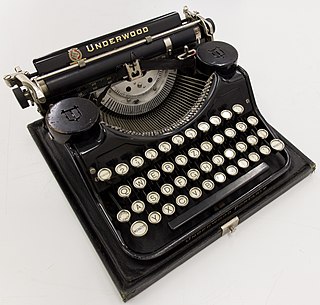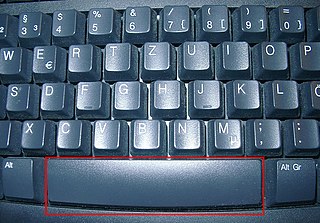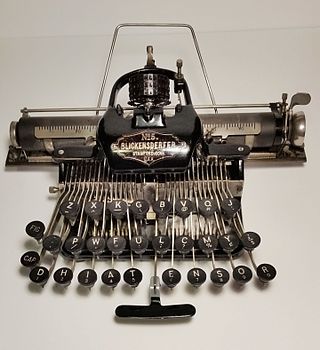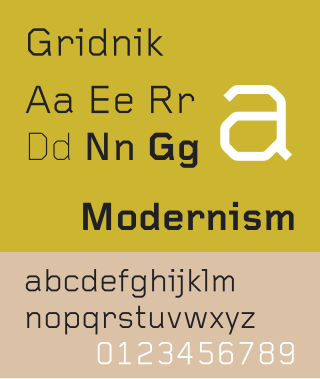
A typewriter is a mechanical or electromechanical machine for typing characters. Typically, a typewriter has an array of keys, and each one causes a different single character to be produced on paper by striking an inked ribbon selectively against the paper with a type element. At the end of the nineteenth century, the term 'typewriter' was also applied to a person who used such a device.

The IBM Electric were an early series of electric typewriters that IBM manufactured, starting in the mid-1930s. They used the conventional moving carriage and typebar mechanism, as opposed to the fixed carriage and type ball used in the IBM Selectric, introduced in 1961. After 1944, each model came in both "Standard" and "Executive" versions, the latter featuring proportional spacing.

In typography, emphasis is the strengthening of words in a text with a font in a different style from the rest of the text, to highlight them. It is the equivalent of prosody stress in speech.

E. Remington and Sons (1816–1896) was a manufacturer of firearms and typewriters. Founded in 1816 by Eliphalet Remington in Ilion, New York, on March 1, 1873, it became known for manufacturing the first commercial typewriter.

The space bar, spacebar, blank, or space key, Space bar is a key on a typewriter or alphanumeric keyboard in the form of a horizontal bar in the lowermost row, significantly wider than all other keys. Its main purpose is to conveniently enter a space, e.g., between words during typing.

A type foundry is a company that designs or distributes typefaces. Before digital typography, type foundries manufactured and sold metal and wood typefaces for hand typesetting, and matrices for line-casting machines like the Linotype and Monotype, for letterpress printers. Today's digital type foundries accumulate and distribute typefaces created by type designers, who may either be freelancers operating their own independent foundry, or employed by a foundry. Type foundries may also provide custom type design services.

The Blickensderfer typewriter was invented by George Canfield Blickensderfer (1850–1917) and patented on April 12, 1892. Blickensderfer was a nephew of John Celivergos Zachos, the inventor of the stenotype. Two models, Model 1 and Model 5, were unveiled to the public at the 1893 World's Columbian Exposition in Chicago. The Model 5 was a stripped-down version of the bigger, more complex Model 1. These machines were intended to compete with larger Remington, Hammond and Yost typewriters, and were the first truly portable, full-keyboard typewriters. The design also enabled the typist to see the typed work, at a time when most typewriters were understrike machines that concealed the writing. When Blickensderfer unveiled his small Model 5, its compactness and novel features attracted huge crowds and many orders.

A foundry is a factory that produces metal castings. Metals are cast into shapes by melting them into a liquid, pouring the metal into a mold, and removing the mold material after the metal has solidified as it cools. The most common metals processed are aluminum and cast iron. However, other metals, such as bronze, brass, steel, magnesium, and zinc, are also used to produce castings in foundries. In this process, parts of desired shapes and sizes can be formed.

In typography, a slab serif typeface is a type of serif typeface characterized by thick, block-like serifs. Serif terminals may be either blunt and angular (Rockwell), or rounded (Courier). Slab serifs were introduced in the early nineteenth century.
Smith Corona is an American manufacturer of thermal labels, direct thermal labels, and thermal ribbons used in warehouses for primarily barcode labels.

Lucien Stephen Crandall was an American inventor of typewriters, adding machines and electrical devices. Crandall gave his name to several typewriters, and he was also involved in the development of various machines, such as the project to produce the Hammond design at the Remington factory, or later the International typewriter.

The IBM Selectric was a highly successful line of electric typewriters introduced by IBM on 31 July 1961.

The Sholes and Glidden typewriter was the first commercially successful typewriter. Principally designed by the American inventor Christopher Latham Sholes, it was developed with the assistance of fellow printer Samuel W. Soule and amateur mechanic Carlos S. Glidden. Work began in 1867, but Soule left the enterprise shortly thereafter, replaced by James Densmore, who provided financial backing and the driving force behind the machine's continued development. After several short-lived attempts to manufacture the device, the machine was acquired by E. Remington and Sons in early 1873. An arms manufacturer seeking to diversify, Remington further refined the typewriter before finally placing it on the market on July 1, 1874.

American Typewriter is a slab serif typeface created in 1974 by Joel Kaden and Tony Stan for International Typeface Corporation. It is based on the slab serif style of typewriters; however, unlike most true typewriter fonts, it is a proportional design: the characters do not all have the same width. American Typewriter is often used to suggest an old-fashioned or industrial image. It was originally released in cold type (photocomposition) before being released digitally. Like many ITC fonts, it has a range of four weights from light to bold and separate condensed styles. Some releases do not have italics.

Gridnik is a geometrical typeface designed by Dutch graphic designer Wim Crouwel, in 1974. It is the digital version of the typewriter typeface Olivetti Politene.
Schriftguss AG was a type foundry in Germany founded in 1892 under the name Brüder Butter by purchasing the type casting firm of Otto Ludwig Bechert that had been founded in 1889. It was later incorporated in 1922 as Schriftguss A.-G. vorm. [prev.] Brüder Butter. Their types were known for “vigour, liveliness and freshness.” Though some faces were done in house, the foundry mainly worked with outside “Schriftkünstler”, more than was typical at the time. A unique product of the foundry were modular systems of “Plakattype” to compose shapes and letterforms for display and jobbing applications, for instance Dekora, or Albert Auspurg’s 1931 Ne-Po (negative–positive), and finally Super-Plakattype in 1949. After the Nazi seizure of power in 1933 the last of the Butter brothers resigned from the corporation and it was changed to a limited partnership. In 1948 the company was expropriated by the post-war communist government and became public property, under the name VEB Schriftguss Dresden, eventually becoming merged into VEB Typoart – Drucktypen, Matrizen, Messinglinien in 1951. As a state run enterprise, the foundry lost its verve and panache and settled into producing serviceable type without distinction.
The Inland Type Foundry was an American type foundry established in 1894 in Saint Louis, Missouri and later with branch offices in Chicago and New York City. Although it was founded to compete directly with the "type trust", and was consistently profitable, it was eventually sold to ATF.

James Bartlett Hammond was an American journalist, inventor, entrepreneur, and philanthropist.
Vari-Typer is the brand name of a variable-spacing typewriter used between the 1930s and the early 1980s in printing, as well as for the production of office documents of typographic quality.
















